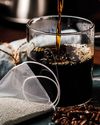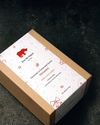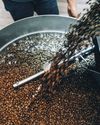A hot cup of coffee isn’t always what you want in summer. So why not try a cold one? As Mersa Auda reports, this sector of the market is growing – and becoming more innovative – day by day

On a scorching summer day, even the most devoted speciality coffee drinker would happily trade their espresso or flat white for a chilled, refreshing drink. Ideally, it should still taste like coffee, while meeting the standards connoisseurs have come to appreciate and expect. So where to turn?
Iced coffee was invented to satisfy this need, but it does not fit the bill for most. The combination of brewing the coffee with hot water and then chilling it (which flattens nuances in flavour), coupled with the addition of sugar, milk or other ingredients used to balance the bitterness, results in a drink that is nothing like a cup of superior-quality coffee.
Then came along the cold brew, where coarsely ground coffee is soaked in cold water for between 12 and 24 hours. This far gentler process brings out a very different tasting profile. It’s smoother and less acidic, preserving the natural sweetness of the bean and making the drink perfectly enjoyable on its own. Cold brew began appearing in speciality coffee shops a few years back, either in a sophisticated Oji cold drip tower or as a homemade infusion kept in large jars or hand-labelled glass bottles. Demand soon outgrew the small batches available, and a conveniently pre-packaged, portable version was the inevitable next step.
No country for cold men
The pioneers of canned coffee as a concept are the Japanese, who began offering this alternative decades before it became popular elsewhere in the world. Aluminium-encased coffees can be found everywhere in Japan, from convenience stores to vending machines, and some can even be consumed hot after immersing the can in warm water for a few minutes. It’s popular enough to be endorsed by A-list celebrities including, rather bizarrely, grumpy-faced Oscar winner Tommy Lee Jones (see below).
Diese Geschichte stammt aus der June - July 2018-Ausgabe von Caffeine.
Starten Sie Ihre 7-tägige kostenlose Testversion von Magzter GOLD, um auf Tausende kuratierte Premium-Storys sowie über 8.000 Zeitschriften und Zeitungen zuzugreifen.
Bereits Abonnent ? Anmelden
Diese Geschichte stammt aus der June - July 2018-Ausgabe von Caffeine.
Starten Sie Ihre 7-tägige kostenlose Testversion von Magzter GOLD, um auf Tausende kuratierte Premium-Storys sowie über 8.000 Zeitschriften und Zeitungen zuzugreifen.
Bereits Abonnent? Anmelden

The Future Of Decaf?
A US company claims its pouch extracts caffeine without harming flavour

Great Coffee Shouldn't Cost The Earth
Caffeine’s editor-at-large Tim Ridley explains how to lower the environmental impact of your coffee-drinking habit

What The F**k...Is Honey Processing?
Apart from natural and washed coffees sits a whole other category, as Sierra Wen Xin Yeo explains

The grind
SEASONAL COFFEE

Tea with purpose
Michelle and Rob Comins explain how tea can be a force for good

Ten years on
We celebrate the London Coffee Festival’s first decade with a look at its successes

Chocolate and espresso pavlova with fennel roasted grapes
This year I’m giving coffee centre stage on the Christmas dessert table. I firmly believe coffee shouldn’t just be an afterthought to accompany dessert, it should be the dessert – but aside from that, it just makes sense.

Bitter Barista
Latte art competitions have been milking it for too long – they used to be fun, but now their focus on the wrong things is harming barista skills, says our cantankerous columnist

What The F**k ...Is The Maillard Reaction?
It’s just one of the elements you need to know about if you’re going to roast coffee successfully, as Edgaras Juška explains

Work Wonders
Coffee gets people through the working day. So it stands to reason that better coffee produces better work – and in some places the two are in perfect harmony, says Phil Wain